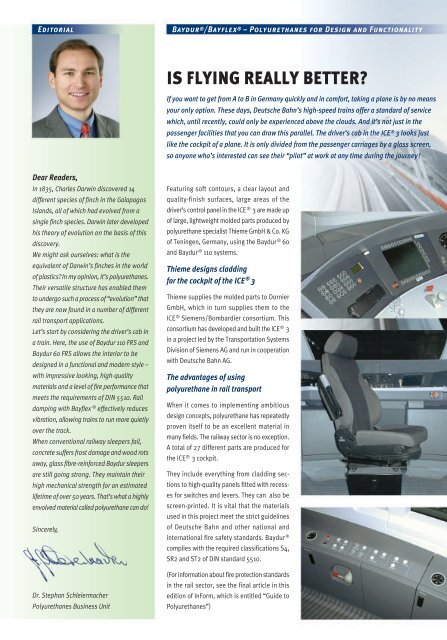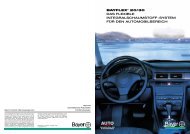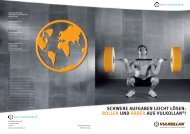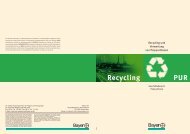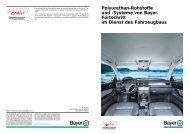Here - Polyurethanes - Bayer
Here - Polyurethanes - Bayer
Here - Polyurethanes - Bayer
Create successful ePaper yourself
Turn your PDF publications into a flip-book with our unique Google optimized e-Paper software.
Editorial<br />
Dear Readers,<br />
In 1835, Charles Darwin discovered 14<br />
different species of finch in the Galapagos<br />
Islands, all of which had evolved from a<br />
single finch species. Darwin later developed<br />
his theory of evolution on the basis of this<br />
discovery.<br />
We might ask ourselves: what is the<br />
equivalent of Darwin’s finches in the world<br />
of plastics? In my opinion, it’s polyurethanes.<br />
Their versatile structure has enabled them<br />
to undergo such a process of “evolution” that<br />
they are now found in a number of different<br />
rail transport applications.<br />
Let’s start by considering the driver’s cab in<br />
a train. <strong>Here</strong>, the use of Baydur 110 FRS and<br />
Baydur 60 FRS allows the interior to be<br />
designed in a functional and modern style –<br />
with impressive looking, high-quality<br />
materials and a level of fire performance that<br />
meets the requirements of DIN 5510. Rail<br />
damping with Bayflex ® effectively reduces<br />
vibration, allowing trains to run more quietly<br />
over the track.<br />
When conventional railway sleepers fail,<br />
concrete suffers frost damage and wood rots<br />
away, glass fibre-reinforced Baydur sleepers<br />
are still going strong. They maintain their<br />
high mechanical strength for an estimated<br />
lifetime of over 50 years. That’s what a highly<br />
envolved material called polyurethane can do!<br />
Sincerely,<br />
Dr. Stephan Schleiermacher<br />
<strong>Polyurethanes</strong> Business Unit<br />
Baydur ®/Bayflex ® – <strong>Polyurethanes</strong> for Design and Functionality<br />
IS FLYING REALLY BETTER?<br />
If you want to get from A to B in Germany quickly and in comfort, taking a plane is by no means<br />
your only option. These days, Deutsche Bahn’s high-speed trains offer a standard of service<br />
which, until recently, could only be experienced above the clouds. And it’s not just in the<br />
passenger facilities that you can draw this parallel. The driver’s cab in the ICE ® 3 looks just<br />
like the cockpit of a plane. It is only divided from the passenger carriages by a glass screen,<br />
so anyone who’s interested can see their “pilot” at work at any time during the journey !<br />
Featuring soft contours, a clear layout and<br />
quality-finish surfaces, large areas of the<br />
driver’s control panel in the ICE ® 3 are made up<br />
of large, lightweight molded parts produced by<br />
polyurethane specialist Thieme GmbH & Co. KG<br />
of Teningen, Germany, using the Baydur ® 60<br />
and Baydur ® 110 systems.<br />
Thieme designs cladding<br />
for the cockpit of the ICE ® 3<br />
Thieme supplies the molded parts to Dornier<br />
GmbH, which in turn supplies them to the<br />
ICE ® Siemens/Bombardier consortium. This<br />
consortium has developed and built the ICE ® 3<br />
in a project led by the Transportation Systems<br />
Division of Siemens AG and run in cooperation<br />
with Deutsche Bahn AG.<br />
The advantages of using<br />
polyurethane in rail transport<br />
When it comes to implementing ambitious<br />
design concepts, polyurethane has repeatedly<br />
proven itself to be an excellent material in<br />
many fields. The railway sector is no exception.<br />
A total of 27 different parts are produced for<br />
the ICE ® 3 cockpit.<br />
They include everything from cladding sections<br />
to high-quality panels fitted with recesses<br />
for switches and levers. They can also be<br />
screen-printed. It is vital that the materials<br />
used in this project meet the strict guidelines<br />
of Deutsche Bahn and other national and<br />
international fire safety standards. Baydur ®<br />
complies with the required classifications S4,<br />
SR2 and ST2 of DIN standard 5510.<br />
(For information about fire protection standards<br />
in the rail sector, see the final article in this<br />
edition of InForm, which is entitled “Guide to<br />
<strong>Polyurethanes</strong>”)


